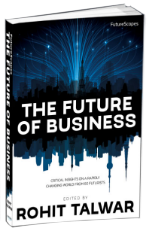20 Mar SXSW, STEAM 3 and the Future of Education
SXSW came and went, and in the weeks surrounding this mother of all conferences, Austin was abuzz with events that forebode what’s to come in the future of education. The weekend prior to SXSW an event called STEAM3 set off. STEM is better known an acronym for science, technology, engineering, arts and mathematics – the core subjects expected to rise in demand for future innovation. Insert ‘Art’, and you get a STEAMing of creativity to drive that innovation. The acronyms have become the new buzzwords that trigger our hopes as well as our fears for those who believe there is a growing disconnect between 20th century education and the learning model our future depends on. The rate of technological change is undergoing an escalation similar to Moore’s Law, or the Law of Accelerating Returns – its close reiteration coined by singularity guru Ray Kurzweil. The reality is that while the rate of technological innovation and resulting labor shortages or surpluses are expected to grow exponentially, our education system is still stuck in a preindustrial model. And we obviously can’t educate our children for the jobs of tomorrow if our education system can’t keep up.
 Outside the auditorium an interactive playground was set up by the various actors in the tinkering and maker movement. The STEAM3 event was arranged by entrepreneur, futurist and mother Maggie Duval and my longtime futurist colleague Derek Woodgate, a well-respected keynote speaker, experienced media- and entertainment futurist and world citizen. Spanning from computer science and online education to gaming and digital storytelling, and digital visual arts, the speakers were all credentialed professionals.
Outside the auditorium an interactive playground was set up by the various actors in the tinkering and maker movement. The STEAM3 event was arranged by entrepreneur, futurist and mother Maggie Duval and my longtime futurist colleague Derek Woodgate, a well-respected keynote speaker, experienced media- and entertainment futurist and world citizen. Spanning from computer science and online education to gaming and digital storytelling, and digital visual arts, the speakers were all credentialed professionals.
The presentations tied in with hot and contentious issues that currently spawn a great deal of attention from futurists, education advocates and generational experts. We gleaned insights from some of the newest technologies in immersive gaming and digital educational experiences. Gamification in education, which I wrote about in Gamification – Learning is What Happens When You Play, is creeping into conventional arenas because it completely changes the learning context and helps individualizing goals and performance parameters. We also heard from various types of alternative educators delivering different educational experiences varying from schools, camps and maker spaces around the tinkering concept to individualized, Montessori-style approaches. Some were high tech and focusing mostly on computer coding and robotics. Others seemed remarkably low tech, but all pitched a devotion to empower individuals and self-motivated learning. We heard how societal safety obsessions are often hindering our children’s exploration instincts, referencing Gever Tully’s TED talk 5 Dangerous Things You Should Let Your Children Do. A panel of alternative educators elicited an interesting discussion with the audience on whether the competition from private education would help move the public school system over into new directions or whether the private alternatives instead would increase the brain drain that is already siphoning resources from public schools in high risk communities. I tend to believe the latter version myself, having read Diane Ravitch’s book Reign of Error where she thoroughly substantiates the negative impact the various types of charter schools often have had on public education. Mostly because unlike public schools, these can often bypass accountability standards and because they find loopholes to funnel parts of the educational budget over to private investors. Ravitch has a long career track in the public education domain, so she’s hardly neutral, but her facts are hard to denounce.
Maria Anderson’s Living Classroom – Personal Learning gave a thorough analysis of disadvantages and opportunities in the world of online learning. As a seasoned online math teacher and futurist herself Dr. Anderson addressed the highly debated question: Is MOOC good enough? Is the online learning format a good substitute for brick and mortar facilities? Believers in online learning are quick to point to a study from U.S. Department of Higher Education that online learning produced better outcomes than its face-to-face alternatives. This fact alone does not address the enormous attrition rates from online educators. Furthermore, if you go by the findings of an investigation carried out by New York Times on online charter schools the results are even more dismal. The two studies may not be entirely comparable because the charter school study involves only K-12 classes. But it made Anderson’s observations even more relevant. She mentioned that in education, social interaction is absolutely essential. Without good student – teacher communication the ground for fruitful learning experiences is pretty arid. I would think this particularly is the case for younger children since their developmental needs are so much more complex than attaining pre-academic competence alone. This is especially true for low-income children who often lacks the basic social support and for whom concepts like K12 could be a disaster unless these issues are addressed and compensated for. In many low-income areas, access to a good brick-and-mortar facility with certified adult teachers are many children’s only escape from abuse, neglect and malnutrition.
Kayla DesPortes, PhD, from Georgia Institute of Technology addressed the problems low-income students face by developing workshops for disadvantaged teens, to gauge interest in Arduino projects with various techie themes. She stressed that a good learning environment must be authentic. To be authentic, the subjects learned must be personally meaningful in the real world and provide opportunities of individual assessment.
Which brings me over to the SXSW Interactive part. I didn’t have a badge this year, but PBS Kids invited me to see a panel debate called Hacking the Princess Culture: Girls, Games and Science, which was all about getting girls motivated to enter STEM arenas. Panelists Jennifer Oxley (film producer), Lindsey Shepard from Goldieblox and PBS Kids’ VP Sara DeWitt relayed the connection between gender stereotypes commonly depicted in media and girls’ sudden confidence in STEM related subjects around age 8. The power of media was exemplified with facts that non-girly shows like CSI had a strong impact of girls electing careers in forensic science (a 68 percent increase after the show). Contrary to common belief we learned that girls constitute 45 percent of video gamers, yet “girl games are less mentally challenging and typically compartmentalized into “pink sites” (as a mother of three girls I can attest to this!). Nonetheless games like Minecraft is popular with girls but girl often get an aggressive response from boys when they reveal their gender. A 13-year old girl in the audience admitted that she had been told to “go back to the kitchen”! The main take away from this session was that if girls are to be swayed into STEM it has to be a social process. Girls have to be exposed to other girls and have teachers who are women. The panel cited a quote from Geena Davis: “If she can see it she can be it”. So this is not to exclude the boys, but to normalize the idea that STEM is for girls and give them venues where they can interact more freely.
All in all these two weekends and solidified the trends I observe with our youngest generation and allowed me to play in the sandboxes that will shape Homelanders’ educational futures. My educational foray culminated during our last local World Future Society’s monthly meeting where Austin’s thought leader on alternative education, Teri Sperry, came to share her insights with us. She stressed that alternative education is picking up families due to the tension between two incompatible movements, one: the accountability testing rigmarole in public education and, two: the yearning for more meaningful and individualized learning experiences.
Education is the new cold war. We’re competing in an arms race with other countries, hence feeding the angst that produce academic testing leviathans that teach our children how to solve trick questions rather than meaningful content. The learning experience then becomes artificial, stressful and with little relevant to the students’ personal aspirations. At worst we end up with student burn-out before their real educational journey even starts. This will continue to drain the public schools for students and teachers with talents and access to resources, and only worsen the situation. From a game theory point of view it seems that education is locked into a “prisoner’s dilemma” stalemate, where we are too scared to break the pattern for fear that we’ll lose out instead of winning ahead if we put our children’s needs ahead of international test results. Maybe the problem really goes beyond education. Maybe we have to look at deeper socio-economic structures before any of these challenges can be overcome.
Images: stockimages @ freestockphotos.net and Flickr


Sorry, the comment form is closed at this time.